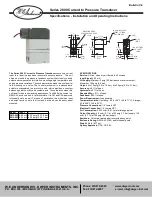
8 - 2
8.1.4 Output Control Circuit (CAH-559)
The unit employs a circuit that controls fluctuations of power to keep the
transmitting output constant. It also has the function to prevent the
transmitting output from
exceeding the ratings. For this purpose, a
positive voltage detected by CD3 is divided into certain voltages by RV1
and RV2, and applied to the negative input pin of IC1. A voltage
determined by R15 and R16 is applied to the positive input pin of IC1.
Vcc1 of HC1 is so controlled that these two voltages may always equal
each other. Thus, the transmitting output is kept constant.
8.1.5 Output Protection Circuit (CAH-559)
This circuit protects the output circuit against excessive load upon
increase of reflected power as when the antenna is released or
short-circuited. CD4 controls the transmitting output by detecting the
reflected power of the transmitting output, and applying it to IC1 to move
the operating point of the output control circuit. Also provided is a circuit
that protects the transistor at the last stage when its temperature
becomes abnormally high. As the temperature of the last stage
transistor case becomes high (above 90 degrees Celsius), the resistance
of R23 increases (from less than 330 ohms to more than 2.2 k-ohms).
As a result, TR5 and TR3 are turned on, and R13 and R15 are connected
in parallel, and IC1 moves the operating point of the output control circuit
to control the output. These circuits do not shut off the output circuit, but
reduces power consumption. Therefore, if the load becomes normal,
the power is automatically restored to the normal output power.
8.1.6 Output Drop Detection Circuit (CAH-559)
This circuit detects the reduction of transmitting output. If the positive
voltage detected by CD3 becomes lower than the setting of RV3, the
output of IC2 goes low to inform the control circuit of the dropping of the
output.
CAUTION: If you turn on the power switch, DC voltage is applied to the
power amplifier circuit. Be careful when checking the interior of the unit.








































